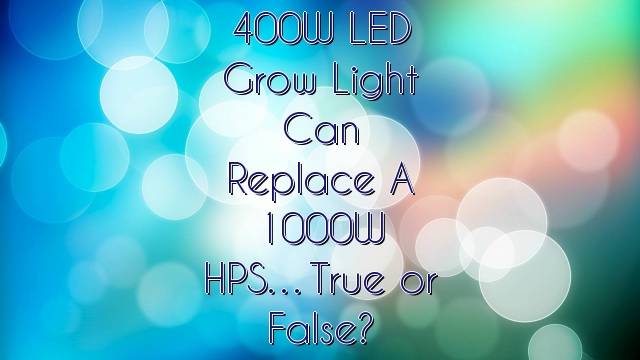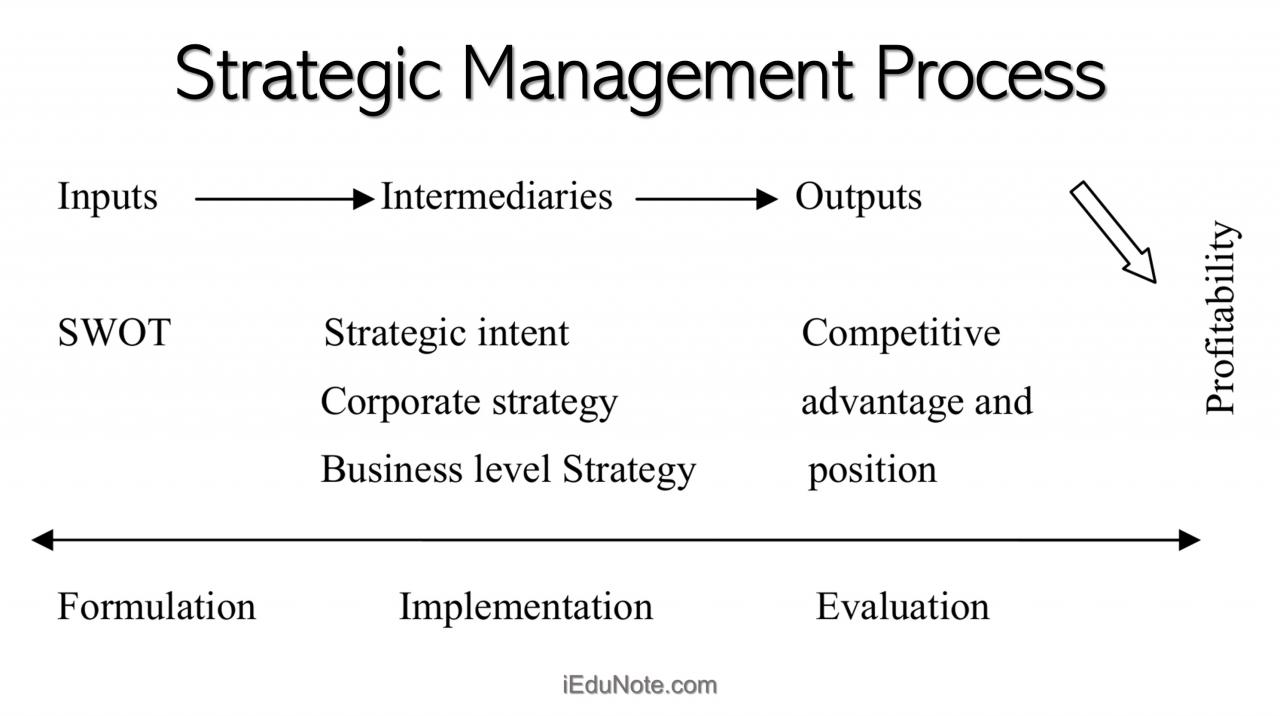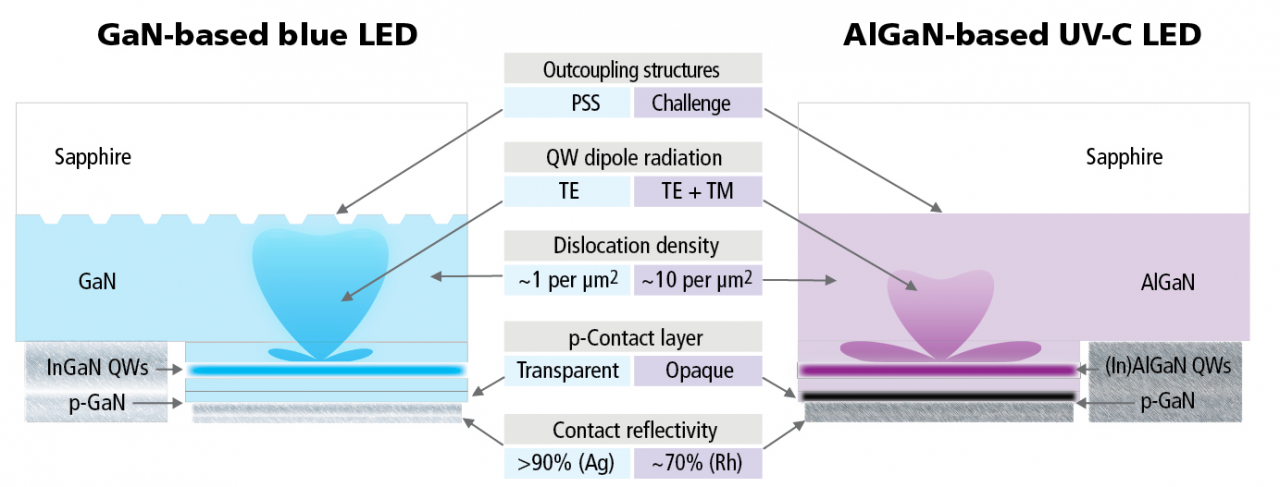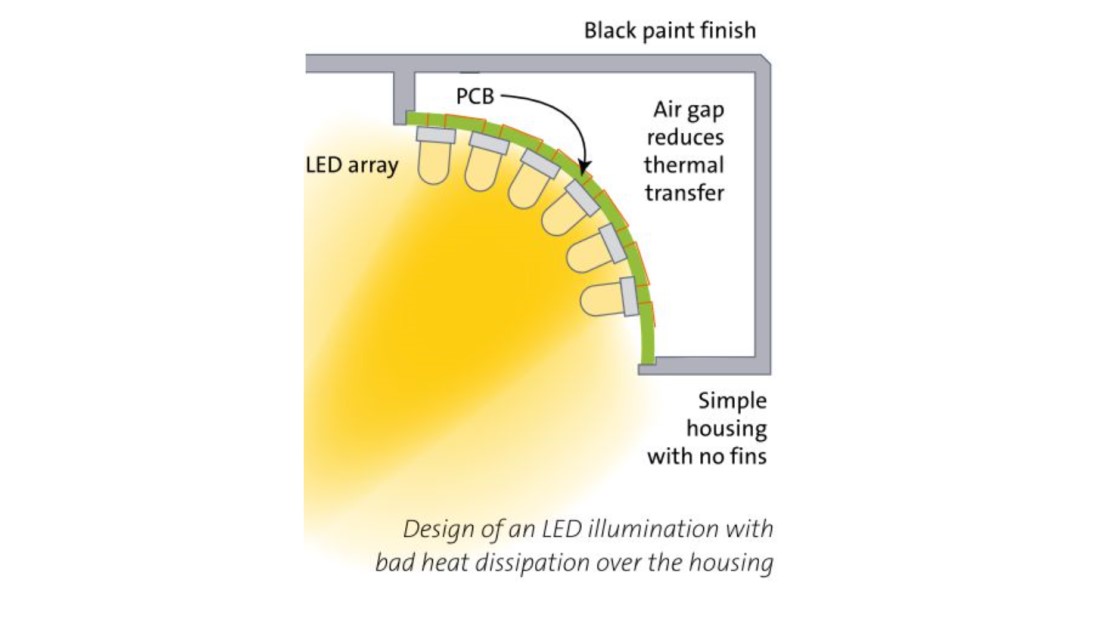
In the horticultural lighting industry, there is a common assumption, frequently reflected in product promotional claims, that just about any 2017 model of a 400W LED grow light can do the job of a 1000-watt high pressure sodium (HPS) fixture and therefore offer a dramatic energy saving. Not so fast.
Watts are watts –HPS or LED….and a “PPF per watt” and indeed mean the same for HPS or LED. Much is made of the LED spectrum being much more plant friendly and more like the famous McCree curve1. But when all is said and done, HPS has been the horticultural industry workhorse for many years, growing just about everything. So its spectrum cannot be all that bad, can it?
It Is true that the HPS PPF/watt fixture numbers, somewhat misleadingly, are based on bare-bulb specifications. Furthermore, when power supply and reflector losses are factored in, a double-ended (DE) HPS fixture is only about 75-80% as good as it seems. If for comparison, we instead use an older, single-ended type of HPS, with its 30% less efficiency, we can drop it down to 50%. Then, if we purposely pick a particular LED spectrum of highest PPF (regardless of its practical relevance), we can concoct a comparative result which says that the 400W can do the equivalent of our old generation HPS-like publishing car MPG data based on driving only on a flat surface at constant 40 MPH, with one passenger, AC off and a stiff wind from the rear
But this is a “tortured” comparison. Today’s higher-efficiency double-ended HPS, even with its ballast and reflector losses and less optimal spectrum with its meager blue, is still , generally delivering far more “bang for the buck” than virtually all LED grow lights now available. But more to the story.
Uniformity and its Relevance to Fixture Efficiency
We will see that if we approach 1:1 PPFD uniformity across a grow bed, we can make the actual light delivery dramatically more efficient. To the plants in the outer 50% area of a grow bed in 80-90% of existing grow lights, now getting only 15-40% as much light as in the center, achieving better than 1.5:1 PPFD uniformity an be the equivalent doubling the PPF/watt number.
Virtually all LEDs, whether bare chips or packaged as an SMD or COB device, exhibit a beam angle of about 120 degrees. That means straight ahead, the beam is at its maximum intensity, but off to the side, the beam gets weaker, and at 60 degrees to either side, has a 50% intensity reduction.
Figure 1 shows a typical curve (intensity) versus angle, supplied by most LED manufacturers. Beam angle of such an LED is defined as that angle where intensity has dropped to 50% and, for any LED without a lens or reflector, is virtually always about 60 degrees in each direction, described as a 120-degree full beam angle.
Figure 1
It is important to recognize that this curve relates to only emitted beam intensity. What many LED users fail to appreciate is that beam intensity is a very different thing from the light level at the receiving end. If one shines a small LED spotlight on the wall from 12 inches away, the light travels outward in a conical manner and illuminates a circular area on the wall. If we double that distance, the diameter (and radius) of the circular area on the wall will similarly double. No mystery there.
The area of a circle is Pi-R-squared. That means when we doubled the distance and radius of the circle, we actually increase the area of the circle by a factor of 4. Because the area is quadrupled, the available light is now spread across 4 times the area and therefore is only one-fourth the level when we started at 12 inches away. So increasing the distance by 2 does not decrease the light by 2 but rather by a factor of 4.
This is known in physics as the Inverse Square Law. That is, the light decreases according to the inverse of the square of the distance. We saw in Figure 1 how light intensity drops off at an increasing angle. Let’s see what happens when that “inverse square law” comes into play.
Figure 2 shows a profile view of typical a simple grow-light distribution pattern. Because the LEDs have that inherent 120-degree full beam angle (or 60 degree half angle), the grow light likewise exhibits the same beam-angle property, sending out a conical beam of light with a 60 degree beam angle in each direction. At the outer edges of the grow bed, we are receiving light which was emitted at an intensity of only 50%.
Figure 2
Typical Grow Bed Light Distribution
48″x48″ Grow Bed
Notice that the light reaching the outer edge has to travel a much longer diagonal distance, which, at 60 degrees, is twice the distance straight down. From the inverse square law, we learned that twice the distance (and square of that doubling) means a 4: 1 drop in received light level. But in our case, the emitted-light intensity at 60 degrees had already dropped 50% i due solely to the beam-angle emission characteristics of the LED chips. Therefore, out at 60 degrees, we must add the 50% due to the chip-emission drop-off to the 4: 1 drop-off of the inverse square laws. The result is 50% of 1/4th = an 8:1 drop-off.
Figure 3 shows what happens as seen from above-a dramatic drop-off of received light from the center to the outer areas. It doesn’t matter if we are measuring received light in lux, foot-candles or PPF.
Figure 3 Top view of typical grow light unit 13 inches above a 48″ X 48″ grow bed
Figure 1 shows again that curve for beam-angle intensity versus beam angle. But in Figure 4 we will add something rarely seen– and critical to grow-light performance–a curve of the only thing that matters— received light—- versus that beam angle. Any experienced grower knows that only received light is relevant to plant growth. Light intensity at the emission end means absolutely nothing until we know how much of it actually arrives where it is needed (i.e. useable light).
Figure 4 shows again the curve of Figure 1 but with addition of a curve which shows what happens to the received light as both beam angle and distance to the target increase. It quickly becomes apparent that received light drops off at a far more rapid rate than the emitted intensity. This effect on grow-bed PPFD uniformity can come as a shock to small growers not familiar with the physics of light or the training to explain what is happening.
Figure 4
With commercial luminaires, there is much attention given to the Delivered Lumens specification, as opposed to simply the Lumen output spec, which is a guideline but not the whole story until we know how much light arrived.
For a grow light, we substitute PPF for the Emitted Lumens and PPFD for the Delivered Lumens, but the idea is the same. However, with grow lights we have a very major additional consideration. If we go to much trouble to create a grow light of substantial power output and efficiency (in PPF per watt) and then find we have an 8:1 variation in received light across the grow bed, we have to ask: “What kind of yield or crop predictability can we achieve?” The answer is rather obvious.
Near the periphery, the plants are starved for light. In the center there is excessive light. Imagine a golf-course green with 8: 1 variation in the watering and sunlight from the center to the outer portions. The levels of lawn “green-ness” are sure to vary greatly and unacceptably just like Figure 3.
Grow lights are often promoted as having such and such Average PPFD. That figure impacts productivity and profit if the uniformity is worse than 2:1. Figure 5, 6, 7, and 8 show distribution patterns for four established LED grow-light brands.
HPS grow light makers do not generally publish their light patterns but the patterns for optimal grow bed coverage are somewhat similar to that of Company D, with one exception Because of the positioning of double-ended HPS bulbs and related reflector design, the light emission is non-symmetrical. Slightly worse than Company B, light distribution on the right side would be approximately down to 33 % of that in the center. However, the light at the top edge would be down to only about 16%.
With HPS, the large bulb and rather imprecise and asymmetrical reflector optics can makes it more difficult to tailor light distribution, with or without overlapping, to many grow bed layouts.
Figure 5
Figure 6
Figure 7
Figure 8
In the preceding figures, one can see the significant variation in PPFD. One can speculate as to the value of optimizing spectrum, nutrients, software controlled light levels, etc, when we have such dramatically wide variations in light. It is like baker who has an oven with a 1 % accuracy thermostat for average oven temperature the oven itself varies by 40% from one spot to another. You can imagine the results.
In practice, growers have developed some ways to partially offset, but not eliminate, these inherent issues of LED light emission drop-off and the light deterioration due to the inverse square law. This is done in typically four ways:
1) For small installations, with a single compact grow light, that light is often surrounded by four walls covered with reflective foil, sending some of the outer light back toward the grow bed. While tedious, this can improve that 6:1 or 8:1 number (and as bad as 12:1 in the corners) to perhaps no worse than 3:1. An alternative is to use only the center 50% of a 4 ft X 4 ft grow area�that is, gain uniformity but accept a smaller area, more wasted light and less productivity�but at least what is grown is all the same.. Employing these compensating steps makes it less important what the actual grow light LED efficiency is and more important how one executes all the other things. This approach improves the situation but is still very inefficient.
2) With larger, commercial-scale operations, with many fixtures, those fixtures can be positioned in a grid pattern. When close enough to one another, light patterns can overlap (Figure 10) at the grow-bed level. PPFD uniformities of better than 1.5: 1 can be readily achieved. Such overlapping has become a regular practice in the lighting industry not only for grow lights but for most large-area, high-bay, commercial lighting. There is typically some wasted light around the sizes of the facility.
Invariably this approach, in creating a �ceiling of light�, like sunlight also puts light in many areas where there are no crops. Unlike with sunlight there is a cost for such wasted light.
Fixture 1 Fixture 2
Figure 10 Overlapping Light Patterns
3) Sometimes, where only a single fixture is being employed or where light-pattern overlapping is not feasible, it is possible to avoid the serious uniformity degradation caused by wide angles. That solution is to make light fixture footprint nearly as large as the grow bed. Doing so and having hundreds of low-wattage surface mounted LEDs means that there can be hundreds of overlapping low-power beam patterns across the total grow-bed area.
It is somewhat equivalent to a room ceiling covered with one large, smooth, flat-panel of light do that the floor is evenly lighted everywhere. Each grow bed has its own �ceiling of light� This approach can achieve uniformity of 1.2:1 or better. That approach is offered by a few firms but is a) quite expensive b) requires on site assembly and c) because of its size, can be incompatible with supplemental greenhouse lighting.
Consequently, the challenge is to achieve, in a single unit, the uniformity benefit of pattern-overlapping without the high cost They all use the same basic approach: arrays of long, fluorescent-tube-like LED �light bars�, with each light bar having many SMD LEDs, usually its own driver and a long, slim, extruded heat sink. Creating a 4�X 4� fixture to illuminate a 4� X 4� grow bed, as just noted, can achieve excellent, even if not perfect, uniformity. Methods 2 and 3, while improving uniformity still create some wasted light.
4) The only practical way to create PPFD uniformity in a compact fixture is to offset the adverse effects of the diagonal light-travel distance away from the center of the beam.
Figure 11 shows what happens if we move the light source farther and farther away from the grow bed. Normally we would assume�correctly– that the light on the grow bed would decrease more and more, the farther away the light.
Figure 11
However, assume that as we move the light farther away, we employ a collimating optic to narrow the beam in proportion to how far away we move the light. For example, assume we have a light aimed at a wall 13 inches away to form a circle of light on the wall. If we increase that distance, the circle will get larger but weaker. However, if we put a collimating reflector, of an appropriate beam angle, over the light source, we will restore the circle and brightness to the original diameter and light level.
If we keep moving the light farther and farther away, but at same time making the beam angle narrower and narrower, an interesting thing happens. The light circle remains the same, but the distance straight ahead and the diagonal distance become closer and closer to being the same number.
In Figure 11 one can see that at 1� away and no reflector, the diagonal distance (the hypotenuse of the beam angle) at the edge, where beam intensity is already only down to 50%, is double the straight-ahead distance, resulting in edge PPFD being only 1/8th what it is at the center. However, if we put the fixture up at 16 feet, the emitted-light (from figure 1 and 15 degrees) heading to the edge is only slightly more than the straight-ahead distance.
We can avoid the trigonometry here, but suffice it to say that the light reaching the edge from a light source at 16 ft away and 15 degree collimating optic is almost the same as straight ahead, resulting in almost 1:1 PPFD uniform
The Importance of Uniformity in the Determination of Real Fixture Efficiency
In the industry, it is common to describe fixture efficiency in terms of emitted PPF/watt. But what is really important is not the emitted light/per watt but rather the received light per watt.
In the horticultural lighting industry, it is generally accepted that somewhat- excessive light is OK (as long as not accompanied by excessive radiated heat (as can happen with a closely positioned HPS fixture) but inadequate light is �bad�, no matter the source.
A single grow light fixture with a grow-bed uniformity of greater than 2:1 and those with more typical uniformity of 6:1 or even 8:1. are either a) delivering far too much light to the center area of the grow bed, wasting 25-50% of the PPF or b) delivering far too little light to the outer half of the grow bed, wasting that light on poorly developed crops.
SMD or COB LEDs: Which provides better uniformity?
Figure 13
16 COB LEDs, each at 25Watts
400 WATTS TOTAL
Figure 12
225 SMD LEDs, each at 1.75Watts
394 WATTS TOTAL
Figures 12 and 13 show two ways to create a layout of LEDs, in a similarly dimensioned fixtures, to achieve the same approximate amount of power and light. It is sometimes theorized that such an array of SMD LEDs can create a much more uniform pattern of light on the grow bed. But that is not the case. In either arrangement, light comes off the LEDs at the 120 degree beam angle and exhibits the significant non-uniformity, as in Figure 5 through 8. The difference in those min/max figures is due only to the difference in fixture dimensions or hanging distance.
The same rules apply to both approaches. It is impossible to achieve better than 2:1 uniformity unless 1) the fixture is nearly as large as the grow bed itself, 2) there are multiple fixtures with overlapping patterns or 3) optics are employed as in Figure 11.
There is also speculation that use of COBs will create �imaging��for example. might put high intensity spots of red and spot of blue instead of a nice uniform sea of purple (mix of red and blue) But that also is not true unless one puts the COB version less than 12 inches from the grow bed .
In order to get any kind of uniformity(better than 2:1) with a single fixture over a 4� X 4� grow bed, one must place the fixture typically at least 18 inches above and accept the tradeoff in average PPFD because of waste light going off to the side. So yes, a very large number of SMDs can create a smoother pattern of light under close in-conditions which would never exist in a real growing situation. Consequently, the answer to the question is that there is no difference in PPFD uniformity in a real world application. The reasons for using one approach or the other rests in other design, manufacturing and cost reasons.
CONCLUSION
PPFD Uniformity ratios greater than 1.5:1 create inefficiencies in how much of the PPFD becomes useful to what is being grown in the grow bed. Uniformity ratios over 6:1, are common in 90% of LED grow lights in the marketplace. This applies as well as to all conventional HPS fixtures if you place them close enough to put 90% of its light in the grow bed (which no one actually does, because of excessive radiated heat).
With such poor PPFD ratios you might wonder why manufacturers even publish the data. They are really saying to the single-fixture user… �We know our light distribution is poor and degrades crop predictability but we�ll leave it to you to where and how you want to be inefficient.�
You can—-
1) Put the fixture very close, and lose use of the outer 50% area of the grow bed, turning the center area into a much smaller but predictable grow area , or
2) Put it much farther away, creating a more uniform light distribution, but much less light level at each spot, and much wasted light off to the sides�again, very inefficient power use but at least a more predictable crop result.
This all means it is almost pointless to dwell on whether a fixture or particular LED is 1.8 or 2.0 or 2.2 PPF/watt when a more than 100% gain in real efficiency– i.e. productivity– can be achieved by a) better PPF uniformity and b) elimination of light spill off to the side. Ideally, we want 100% of that light to be delivered to the grow bed and the grow bed only. Next, we want all that light to be landing equally on every square inch of the grow bed.
Finally, it should be noted that in an LED-versus-HPS debate, taking advantage of collimation to improve uniformity is something almost impossible to achieve with HPS because it would require at least a 3-foot diameter collimating optic to do it right.
The best so-called 1000 W HPS, after ballast and significant optical losses, really delivers only about 750 watts of useful light to a grow bed . However, available for less than $400, it is only going to be meaningfully threatened by LED technology when a 400W LED unit, whose superior longevity and spectrum options are acknowledged, can also add 1) the dramatic efficiency- equivalency benefit of uniform PPFD and 2) a price point below $600.
Until then, LED grow lights will repeat the history of LED light bulbs and luminaires in the 2002-2006 time period.�much industry buzz and rosy research-report market projections, but no traction. With the lessening of specification smoke and mirrors and a sharp drop in pricing, the commercial LED lighting market did in fact grow dramatically.








